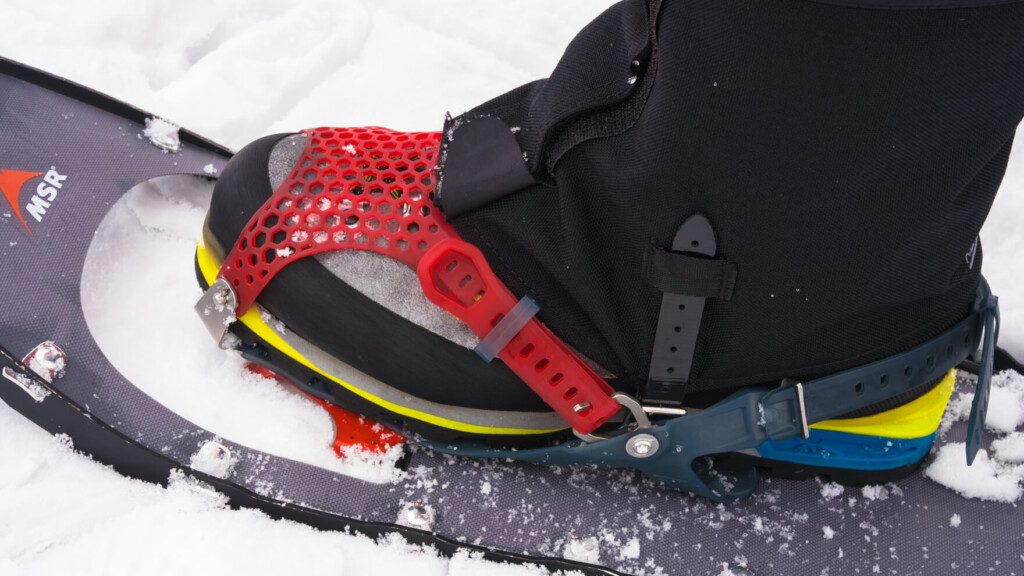
Review: MSR Lightning Ascent The evolved bindings are comfortable to go back once you experience them! [Comparison of new and old models]
The Lightning Ascent series of MSR, a snowshoe that is highly trusted worldwide for its safety and ease of use, has been unexpectedly renewed this season.
I dared to say "No way," because the previous model already boasted a very high level of perfection. It is lightweight and compact, yet offers high grip and high fit, and is also highly durable. It has been widely popular as a snowshoe used in mountains in Japan, where the snow is steep and has a wide range of people, from full-scale backcountry snowboarders to alpinists.
However, when such a well-established aircraft is renovated, there is much more anxiety than expectations. What is the reality...? I immediately compared it with the previous model and checked out the evolution points of the new work.
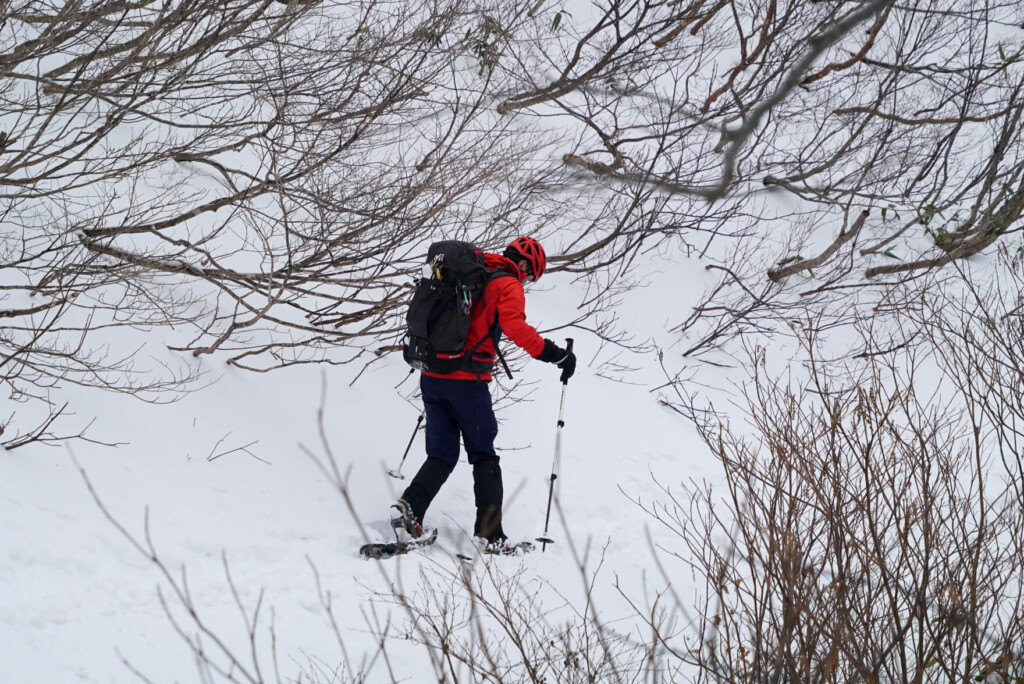
Although it is below the knee, we compared it with Mt. Tanigawa, which is covered in soft snow.
table of contents
- Main Specifications and ratings
- What changed? Detailed comparison review
- Previous models are also on sale
- Basically, nothing changes except for the bindings
- The weight is slightly lighter than the previous model.
- The latest "Paragon Binding" is incredibly easy to wear
- No matter how tight it is, it won't be too tight, and it's amazing how comfortable it is to wear.
- The ease of use has remained the same as ease of walking, grip, and storage.
- Summary: Is the new model "buying"?
Main Specifications and ratings
| item | Lightning Ascent | Lightning 3 Strap Ascent |
|---|---|---|
| Weight (actual measurement of 22 inches) | 1,900g | 1,817g |
| Size (actual measurement of 22 inches) | 20 x 56cm | 20 x 56cm |
| Frame | aluminum | aluminum |
| Cranpon | steel | steel |
| binding | Paragon Binding | Posilock AT binding |
| Float tail | ○ | ○ |
| Women's model | ○ | ○ |
| evaluation | ||
| This is ◎ |
|
|
| (Relatively) this is △ |
|
|
| Ease of putting on and taking off | ★★★★★ | ★★★☆☆ |
| Fixed force | ★★★★☆ | ★★★★★ |
| Ease of walking | ★★★★☆ | ★★★★☆ |
| buoyancy | ★★★☆☆ | ★★★☆☆ |
| grip | ★★★★★ | ★★★★★ |
| weight | ★★★★☆ | ★★★★★ |
| Storageability | ★★★★★ | ★★★★★ |
| Overall score | ★★★★★ | ★★★★★ |
What changed? Detailed comparison review
When I saw the latest model at the exhibition, my honest impression was that I was actually more worried.
This time, the binding has been greatly revamped. The latest model has been changed to "Paragon Binding" with a mesh-like urethane resin that completely covers the instep of the foot. This part can be considered the heart that determines the stability and ease of walking of the shoes. Personally, I'm sure it looked a little more poorer than ever. Due to the harsh environment of winter mountain gear, "resistant to breakage and ease of repair" is one of the most important factors, and I think that this has been damaged, and my interest (or rather, I'm worried?) in the new work was poured into it.
Previous models are also on sale
What I've only learned after it was released is that the latest model will inherit the name "Lightning Ascent," while the models that have been sold up until now will be sold together as "Lightning 3 Strap Ascent." From this point of view, the latest model is not just a simple successor to the previous model, but rather a different variation from the previous model to meet recent needs.
So, here we will carefully compare the differences between the two models sold together, focusing on what kind of users each are prepared for.
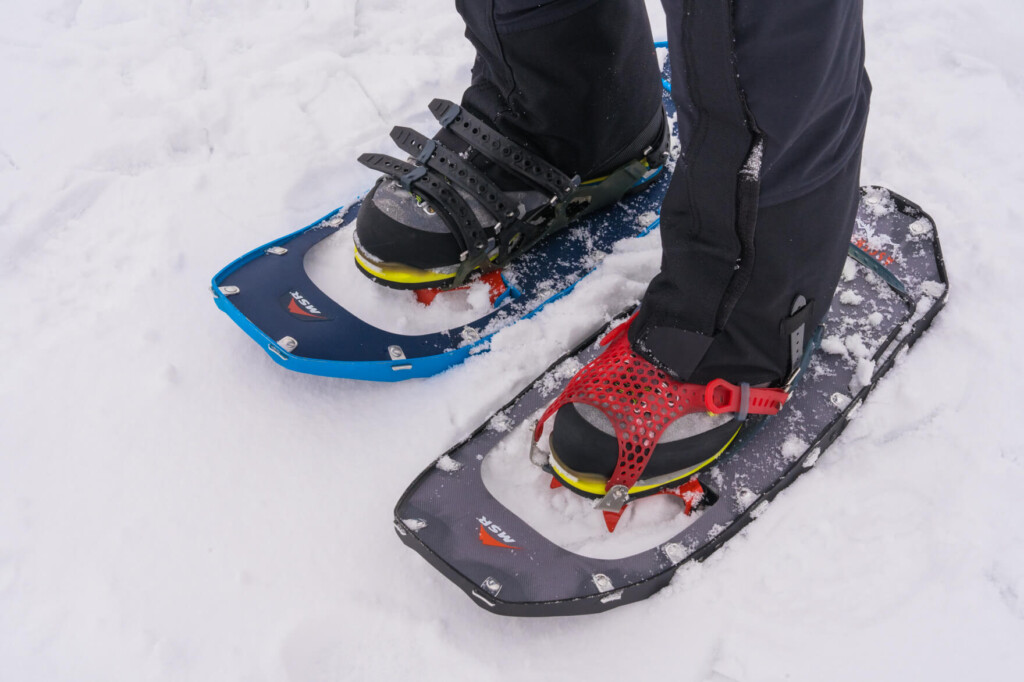
The blue frame model (left) is a traditional three-strap. The black frame (right) is a model that uses the latest Paragon binding.
Basically, nothing changes except for the bindings
The MSR Lightning Ascent has a light and simple construction with an aluminum frame with sawtooths and a durable fabric on the deck. However, its robustness is what you would call an MSR, and although I have been using the previous model for a long time, it has never been broken.
The structure of the latest model has not changed, and when you look at it from the front, you can almost see that there is only a difference between the latest model and the previous model in the binding part.

Turning over, the lightning ascent has a sharp steel clamp with sawtooth edges that allow for 360° traction, a lightning screwdriver.
This is also a new and old model.
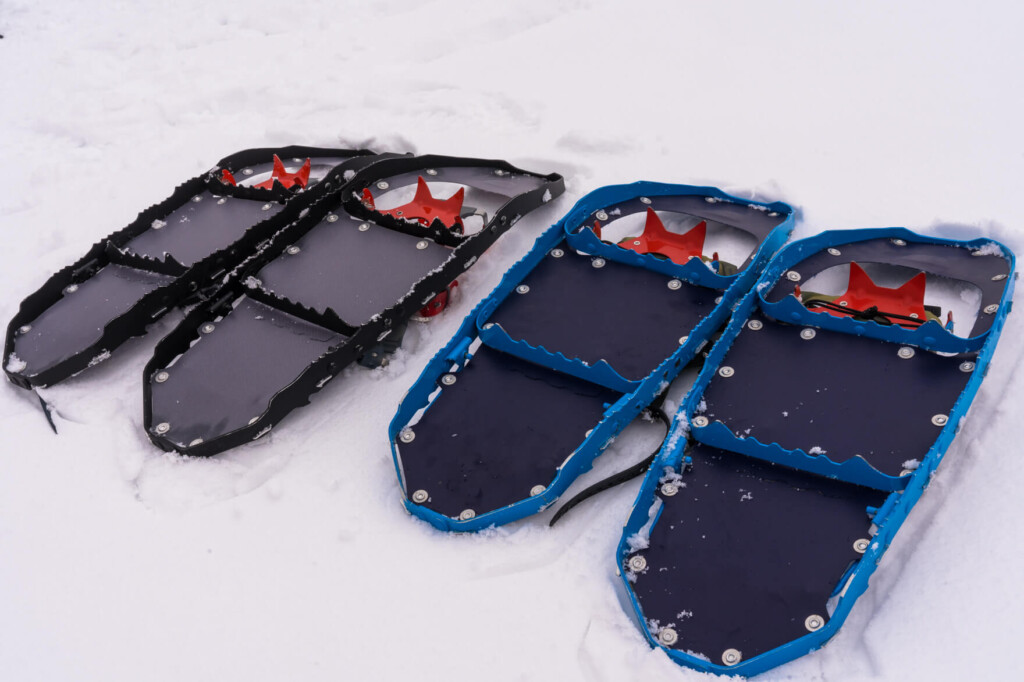
The tail also comes standard with a heel lift (teleft) that makes it easier to climb when climbing sharply. There are no particular changes.
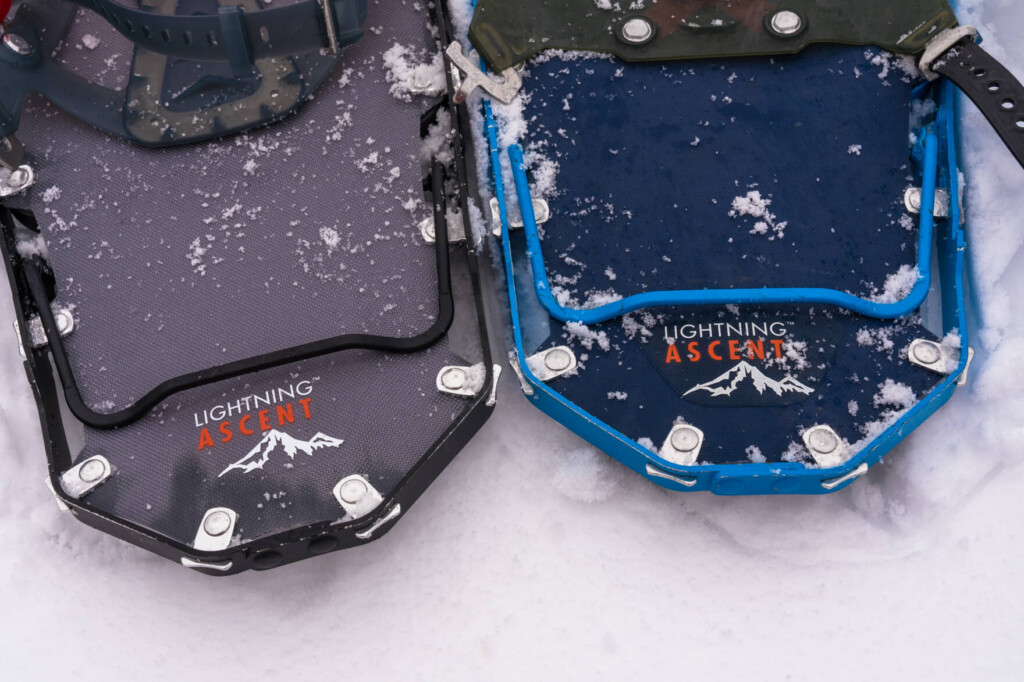
The weight is slightly lighter than the previous model.
When we actually measured the weight of the 22-inch models each, the latest model was 1900 grams, and the previous model was 1817 grams, which was only about 100 grams, but the latest model was heavier. If it's a snowy mountain, you'll be prepared for its weight, and when you're walking around, it's a weight that can be irrelevant depending on the snow conditions, so it's not too bothering you, but be careful if you're thinking of cutting it to the limit. If it's the lightest, it would be the "22-inch 3-strap" model.
The latest "Paragon Binding" is incredibly easy to wear
First off, take a look at the video below, comparing the speed of the fitting.
While it took about 1 minute and 40 seconds to finish wearing both feet on the previous three-strap model, with the latest Paragon Binding, it took me to wear the left and right sides at just under 30 seconds. The latest bindings are amazing.
I am a loyal user of the 3-strap model, and I am (and should have been) a bit used to wearing snowshoes and crampons, so I don't think this number is extremely slow. In particular, the 3-strap model is difficult to determine the front and back position of the foot placement unless you are used to it, and it may take longer for some people. This laborious installation on the previous model was the only weak point that could be said to be the only snowshoes.
On the other hand, with the new Paragon binding, if you match the mesh strap on the front with your shoes in advance, put your foot in the snowshoes and tighten the heel strap at the stop of the toes, you can instantly secure it in the ideal position.
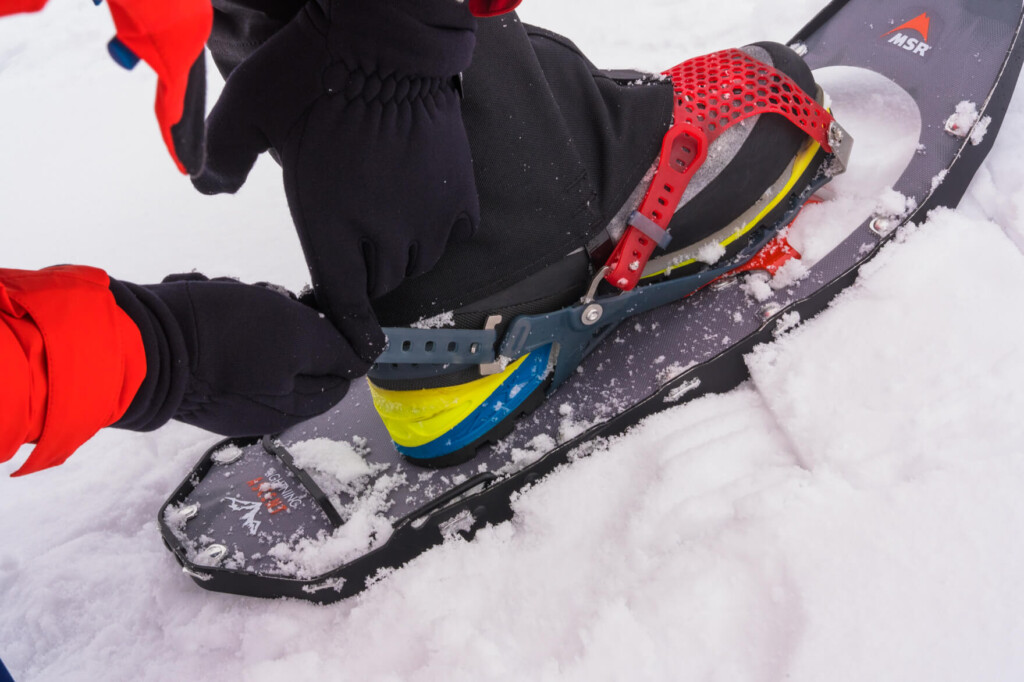
The toes are stopped at the tip, so fixing the heel strap is easier than you might think. This ensures that the front and back of the boots are firmly clamped together, and the ideal position is completed.
Once you've secured the heel strap firmly, all you have to do is pass the excess part through the belt loop.
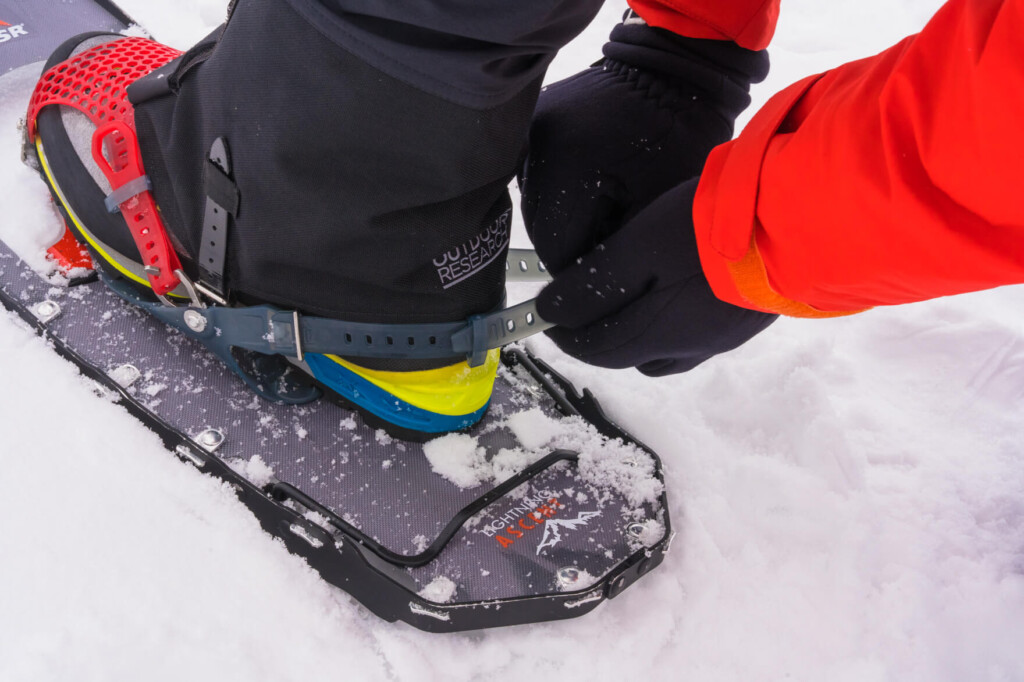
The strap loop is a loop that passes through holes from the conventional hooking method, reducing the risk of it coming off while walking.
Even if you keep them at home, if they don't fit when you actually wear them on the field, you will need to retighten the mesh straps on your toes to make them fit. For more information on how to wear it, please refer to the explanation on the official website

If the shoes still move, tighten the left and right sides of the mesh straps to adjust the tightness. The strap is supple, so you can pull it up and secure it while it is still inside the inner gloves.
Other companies' snowshoes that are easy to put on and take off include models that use the "Boa system." In comparison, fine adjustments are easier with Boa, but when you put on and take off, you will need to tighten and loosen each time. On the other hand, Paragon bindings that are not necessary if you have finished fitting your shoes in advance can be said to provide a much better usability than ever before.
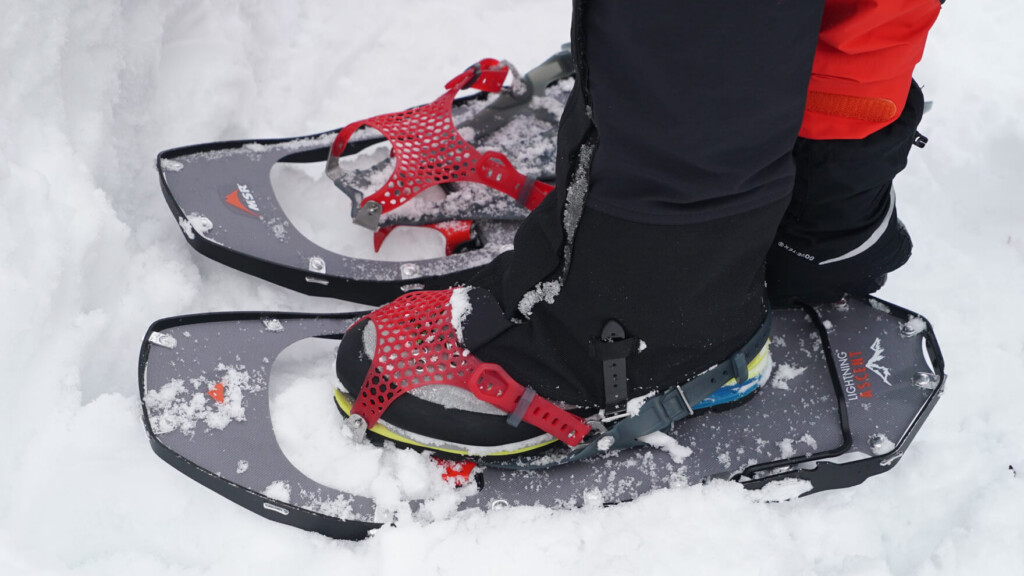
Despite its easy to put on and take off, the mesh straps also had a higher fixing power than I expected.
No matter how tight it is, it won't be too tight, and it's amazing how comfortable it is to wear.
I was shocked by how smooth it was to put on, so I continued my impressions of Tarokoro, which was actually a walk.
The most unexpected thing about the new binding was the change in the feeling of tightness.
The traditional three-strap was simply like strapping the instep with a strap, so you can feel the feeling of whether it is tight or not. If you tighten it, the instep will be pressed (from above the shoes), meaning that if you tighten it too much, it can affect blood flow slightly if you do it too much.
On the other hand, with the latest models, even if they are tightened and fixed, pressure is applied evenly to the entire instep, so there is no sense of pressure. It is very comfortable to wear.

Even if it fits the perfect size, it doesn't feel oppressive and is comfortable to wear.
Nevertheless, the shoes were firmly attached to the binding and did not slip even after walking for long periods of time. This is probably due to the structure that prevents small details from shifting, such as the unevenness (photo below) placed on the forefoot of the binding base.
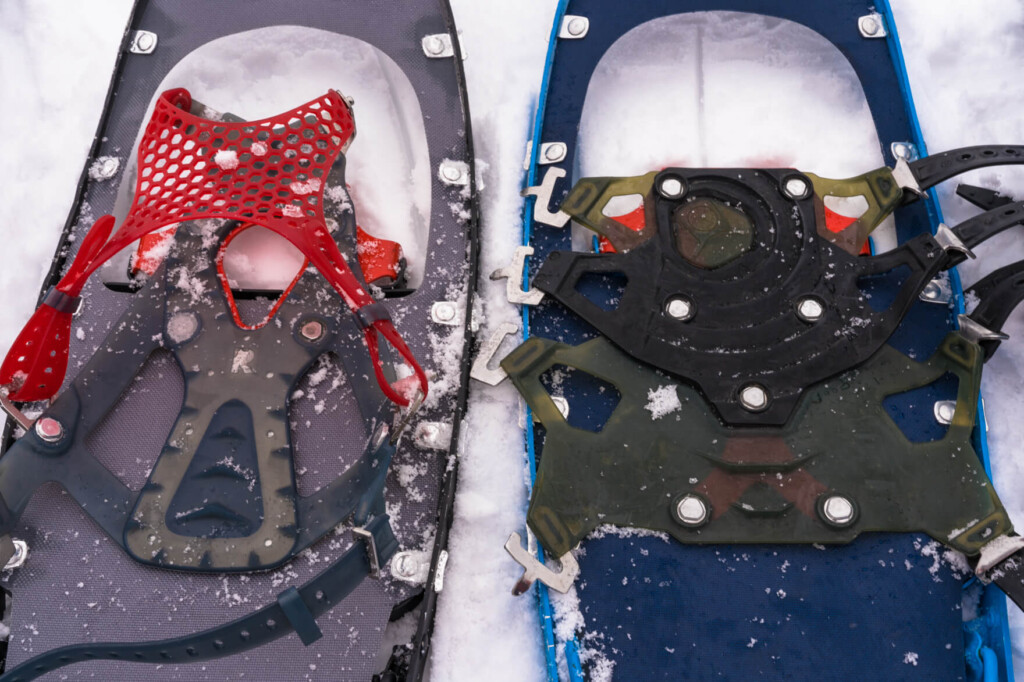
In the paragon binding (left), there are more unevennesses arranged so that the soles of the foot are less likely to slip due to the reduced pressure when tightening the instep.
You can wear large shoes other than mountaineering boots without any problems, but be sure to fit them before purchasing.
I'll also check out whether it would suit larger boots, which I was a little worried about when it came to fitting. I didn't have any boots for the board, so I tried wearing them with backcountry ski boots, which means they were close in size. To put it simply, as shown in the photo below, I was able to easily secure it even with 27cm ski boots.
However, you need to be careful when using large snowboard boots by people with large feet. At that time, I actually saw reviews from overseas that the front strap was a little short. The adjustable size and wide range of types make it even more secure with the traditional three-strap. If you are worried, we recommend fitting it and check it before purchasing.

I don't think there are many cases like this, but I tried wearing it on ski boots to test the size.
The ease of use has remained the same as ease of walking, grip, and storage.
To measure the ability of these snowshoes to deal with deep snow and slopes, I walked around the Tenjin Ridge of Mt. Tanigawa, wearing them separately on both sides.
First of all, what is surprisingly difficult to ignore is the high storage capacity of this model. Compared to other snowshoes, the binding can be crushed flat, so even when attached to a backpack, it is nice that it does not protrude and is easy to carry. It's actually bulkier than Wakan.
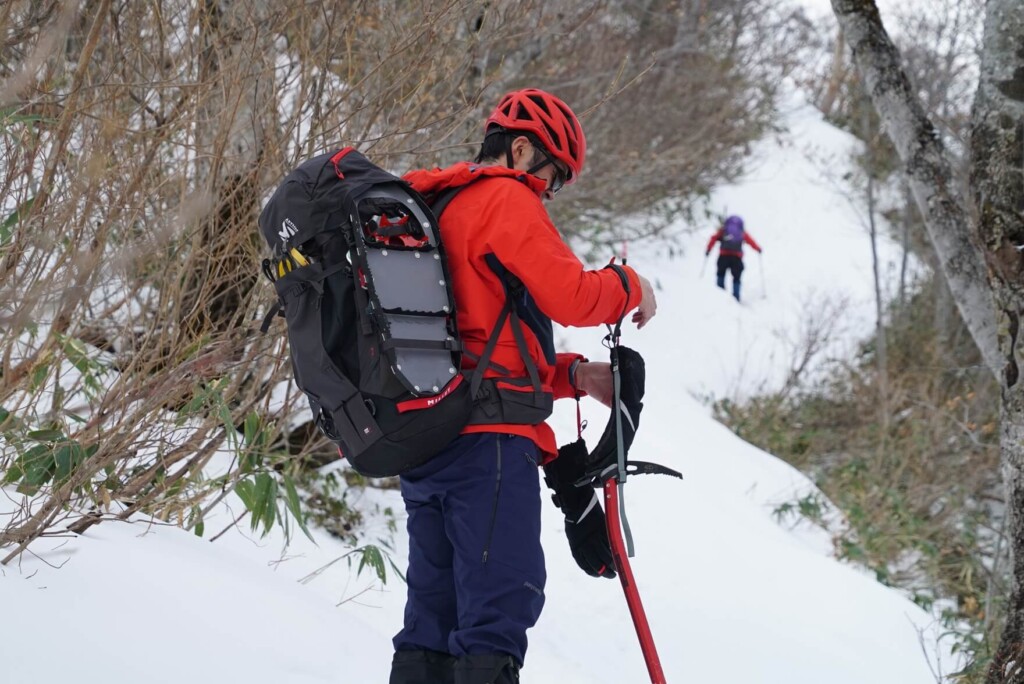
The high storage capacity of these snowshoes is particularly noteworthy. By the way, when you put your teeth outwards like in this photo, be careful not to snag it on your surroundings or on your own clothes. If you're not good at it, you'll end up regretting it a lot.
As I wrote before, the paragon binding, which wraps around the entire instep, does not feel any sense of pressure on the instep, and does not cause any cold blood flow to the toes. Despite this, it was firmly fixed and didn't slip at all even after continuing to put on without taking off the ball throughout the journey. Compared to the three straps, which require a little bit of familiarity to secure them neatly, it is easier for beginners to use.
It is easy to handle and has the same ease of walking experience as the previous model (although it is obvious). Also, regarding the durability that was a concern, as far as I used this time, there was no situation where it was difficult to put a strong load on it.
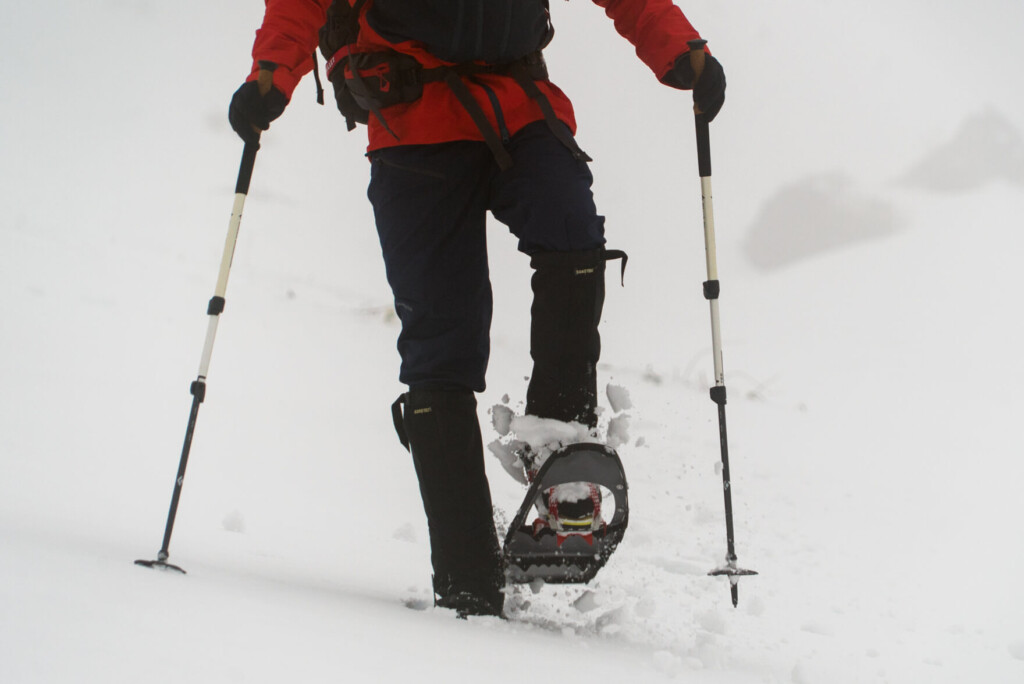
It exhibits decent buoyancy, as before. The fabric deck was comfortable and there was no snow on it.
Furthermore, the 360° sawtooth edge, the biggest weapon in this snowshoe, still showed stable grip even on slope traverses.

The grip works no matter where you set the edge 360°, allowing you to walk safely on slopes.
Even on a slightly hard, steep slope that appears on the ridgeline, I am impressed by the grip that makes it seem like it is necessary for others to change to a clampon (I don't recommend it at all as the dangers vary depending on the weather and snow quality, etc. It is safer to just switch to a clampon).

When the slope becomes more severe, if you raise the heel lift (teleft) you will be able to dig into the snow, even on quite steep slopes, allowing you to climb directly. It's simple to make and easy to operate, so there's no complaints here too.
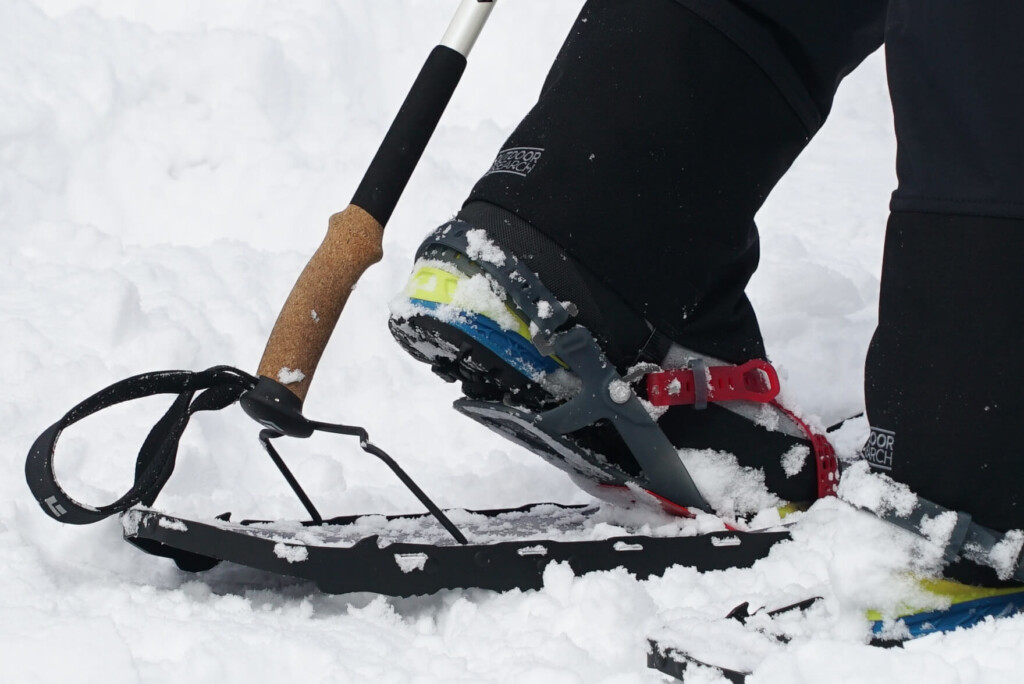
Summary: Is the new model "buying"?
While maintaining the best features of the previous model, which was attractive for its outstanding grip, passing scores, ease of walking, and high storage capacity, it was a great sense of security, while also having the challenge of wearing it surprisingly easily, and even more comfortable to wear, I personally would only say it would be a buy. In the sense that it is ideal for mountains in Japan, where there are many things to put on and take off due to a wide variety of terrain, such as steep slopes, crust slopes, traverse, heavy snow, and wet snow, it can be said that there are fewer blind spots for beginners to experts.
However, from the perspective of "vervanced" and "simplicity", it must be said that in relative terms it is inferior to the simple binding structure of the three-strap model. If you are looking for a sense of light weight and compactness, and the peace of mind that it can be paired with any boot or can be easily repaired, the traditional three-strap is still very valuable.
Which one is better depends on your style. Personally, I have experienced the ease of wearing this and have not been able to go back.




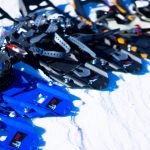 Lineup comparison: We compared MSR snowshoes, so we'll introduce some recommended models.
Lineup comparison: We compared MSR snowshoes, so we'll introduce some recommended models. From snow hiking to backcountry. The entrance to the wonderful snowy mountains, how to choose snowshoes wisely and 5 recommended models
From snow hiking to backcountry. The entrance to the wonderful snowy mountains, how to choose snowshoes wisely and 5 recommended models Review: INOOK FREESTEP Snowshoes from France to enjoy snow hiking
Review: INOOK FREESTEP Snowshoes from France to enjoy snow hiking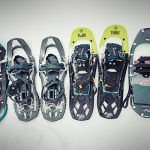 Comparison review: Comparing shoes from the four major snowshoe manufacturers, MSR, ATLAS, TSL, and TUBBS!
Comparison review: Comparing shoes from the four major snowshoe manufacturers, MSR, ATLAS, TSL, and TUBBS!